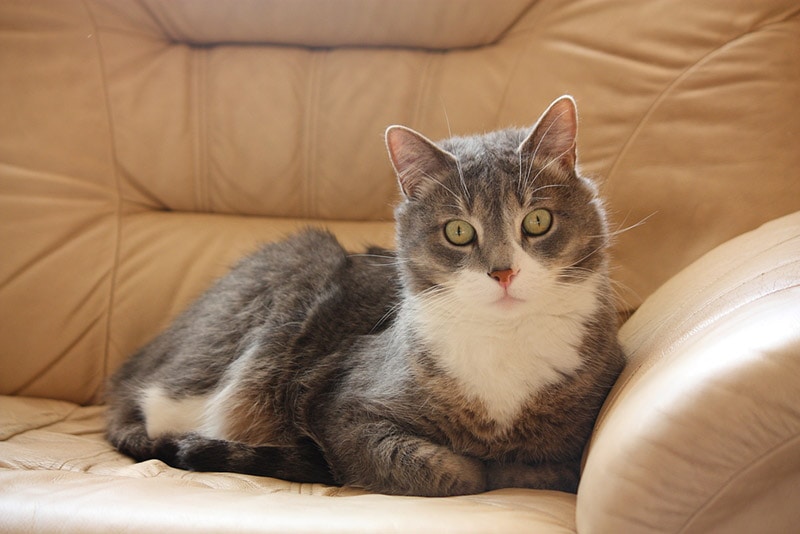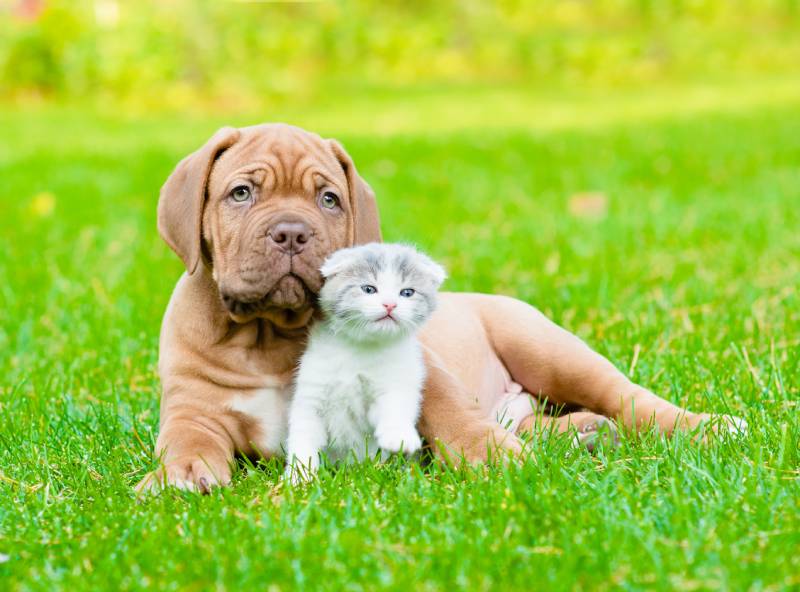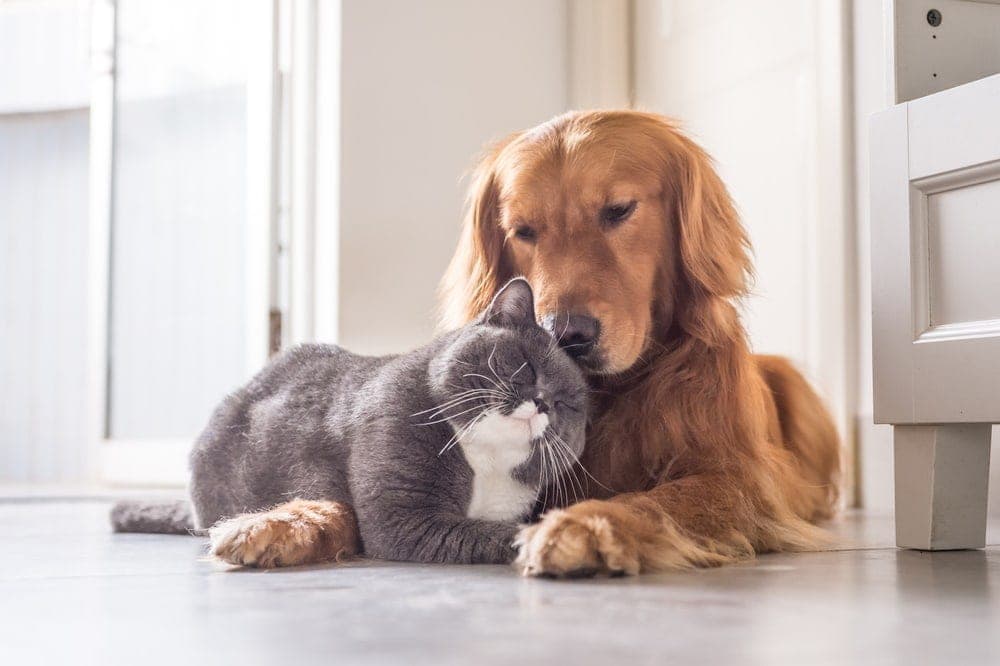Are Mastiffs Good With Cats? 7 Tips to Safely Introduce Them
Updated on

Mastiffs are incredibly large, powerful dogs that might not be happy to see you if they don’t know you. Around their families, however, the Mastiff is a big, sometimes goofy, and surprisingly gentle dog. Mastiffs also do well around children and are very protective, but one question you might have, especially if you have cats at home, is whether Mastiffs are good with cats. The answer is that if they’re raised with cats from puppies, Mastiffs can get along with cats quite well.
However, if an adult Mastiff is introduced to a cat (or cats), it could be problematic as they have a high prey instinct. If they see a cat they don’t know, they won’t necessarily want to kill it, but they will chase after it.
Knowing that a Mastiff can be good with cats (but might not be), you likely have more questions about cats and Mastiffs. To learn more about how to bring a Mastiff and cat together in a friendly union, read on.
Do Mastiffs Hate Cats?
It’s long been held that Mastiffs hate cats (and vice versa), but that’s not exactly true. Mastiffs were bred for hundreds of years to be hunting dogs and have a very potent prey drive still to this day. The average Mastiff loves chasing after any animal, including cats, squirrels, little dogs, and rabbits.
When they see a giant Mastiff, most cats turn tails and run like mad. When an animal runs from a Mastiff, you can bet that it will give chase. In other words, Mastiffs don’t hate cats, but they do love running after them thanks to hundreds of years of hunting behavior.

When Is the Best Time to Introduce a Mastiff to Cats?
The best time to introduce a Mastiff to a cat is when both are babies. It would be best if the Mastiff were no older than 3 months, whereas, with the cat, everything should be fine as long as it’s still a kitten. The younger, the better for the Mastiff, as this will help to significantly reduce its prey drive and turn the cat into its friend rather than something to chase.
You should also note that puppies and kittens raised together get along well versus being introduced as adults. Yes, introducing an adult Mastiff to a cat is possible, and it’s also possible that they become fast friends. However, it’s just as likely they don’t due to the aforementioned high prey drive of the Mastiff. Plus, an older cat might not want anything to do with your new mastiff.
 The 7 Tips to Safely Introduce a Mastiff to a Cat
The 7 Tips to Safely Introduce a Mastiff to a Cat
As we mentioned earlier, it is possible to introduce an adult Mastiff to an adult cat or even a kitten. However, you must go through several steps to ensure that neither one gets freaked out and that your Mastiff doesn’t do anything rash. Below are step-by-step instructions on how to introduce a Mastiff to a cat.
1. Prepare a ‘Sanctuary Room’ for Your Cat
Cats, when seeing a humongous dog, will usually be very unhappy about it and scared and anxious. That’s why you should prepare a room ahead of time where your cat has everything they need (water, food, toys, a perch, etc.) so they can get away from their new Mastiff housemate.
2. Keep Your Mastiff and Cat Apart for the First Few Days
No, they won’t be able to see each other, but you can bet that both will smell and hear the other. That’s all they need for the first few days, just to know the other animal is there.

3. Feed Your Cat on One Side and Your Mastiff on the Other Side of the Same Door
This is similar to Step #2 in that your Mastiff and cat will hear, smell, and might even see each other’s movements under the door. This will get them further used to each other’s presence in your home. If needed, you should do this for at least 3 or 4 days or longer.
4. Bring Your Mastiff and Cat Together in a Common Area
This is the big moment when your Mastiff and cat meet for the first time. Make sure it’s in a neutral area of your home, and keep your Mastiff on its leash at least the first few times. Your cat can move around as it wishes. Closely monitor their reactions and, if either becomes aggressive, distract and separate them. Try again the next day and keep trying until there are no signs of aggression.

5. Let Both Pets Interact Freely
Once it seems like your Mastiff and cat are on good terms, let them interact freely. One tip, however, is to keep a leash on your Mastiff. If they chase the cat for some reason, you can step on its leash to stop it.
6. For the First Few Weeks, When You Leave the House, Separate Your Pets
This will prevent any accidents or aggression while you’re away. Ensure that your cat always has easy access to their sanctuary room.

7. Enjoy a Calm, Loving Home With Your Mastiff and Cat
If you’ve done everything well, and your Mastiff and cat are good with their new living situation, you’ll enjoy a fun time with your precious pets.
 Which Breeds Get Along the Best with Cats?
Which Breeds Get Along the Best with Cats?
If you’re not set on adopting a Mastiff but already have cats at home, you might want to consider a breed that gets along well with cats. You should note, though, that it’s always possible that a cat and dog don’t get along for some reason. Some dogs, for example, will never see cats as anything but “prey.”
You may also bring a Rottweiler or other Alpha dog home that falls head over heels for your cat, so you never know. Below is a list of the best “cat dogs” out there.
- Golden Retriever– possibly the best dog to own if you have cats
- Labrador Retriever– almost as good as the Golden
- Shetland Sheepdog
- Beagle
- Poodle
- Pug
- Basset Hound
- Bulldog
- Collie
- Irish Setter
- Papillon
- Cocker Spaniel
- Maltese
- German Shepherd

Signs a Mastiff Won’t Be Good with Your Cat
Any time you bring together two animal species, there’s a chance they won’t get along, and that’s especially true for cats and dogs. In the Mastiff’s defense, they deal with thousands of years of ingrained behavior patterns. For cats, it’s simply a matter of survival since dogs have been killing cats for eons in the wild.
There are, however, several signs that a Mastiff (or another dog) won’t be OK with a cat. If you see any of them, separate the two immediately and try again, but also consider that the friendship might never take off.
- Growling
- Showing their teeth
- Still, glaring eyes
- Shaking
- Licking its lips
- Your Mastiff tries to separate you from your cat
- The dog stops eating when it sees a cat
Final Thoughts
Like most dogs, a Mastiff raised with cats from the time it’s a puppy will likely become enamored and be best friends. Being raised with cats changes them from “prey” to “family members” in the eyes of most Mastiffs raised with cats. However, some dogs, especially adults, might never be good with cats, especially if they have a history of chasing or killing them.
The good news is that the massive Mastiff, for the most part, is a big, lovable goofball that will get along well with everyone in your family, cats included. If you follow our step-by-step instructions for introducing them, the chance your cats and Mastiff become fast friends is much higher. Whatever happens, we wish you the best of luck for a happy, harmonious, and peaceful mixed-species home!
Featured Image Credit: Volodymyr Burdiak, Shutterstock










